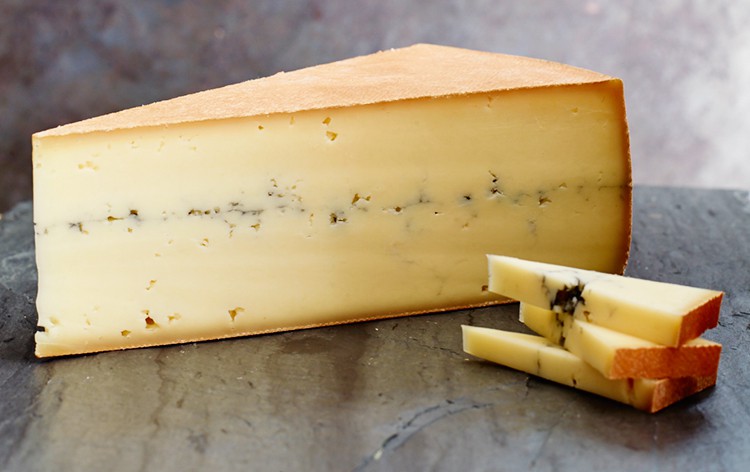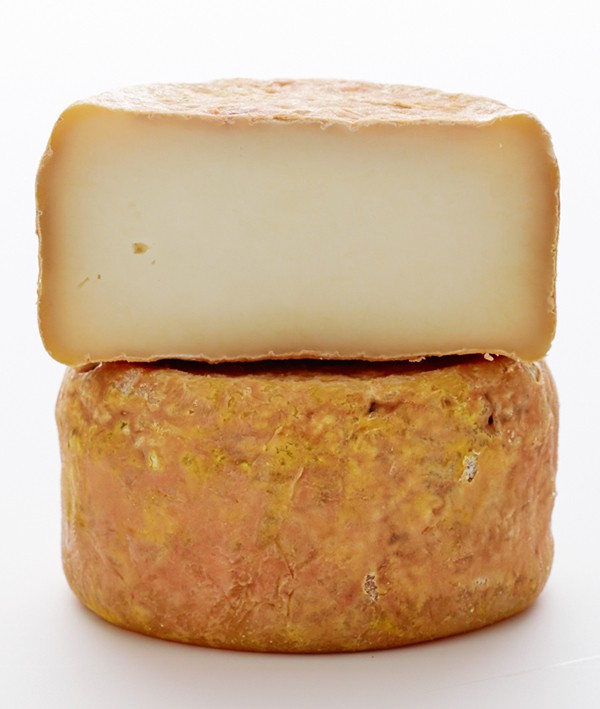
Ladies and gentlemen, get your graters and planes ready: It’s our Best Cheeses guide! In preparation for our upcoming 2016 Best Cheeses issue (on newsstands October 31!), we’ll be breaking down our expertly curated list of 75 oh-so-good wheels and wedges—the stuff of cheese dreams, really.
What’s our process? First we reviewed top finishers from some of the world’s most prestigious contests (held between September 2014 and August 2015): American Cheese Society Judging & Competition, the World Cheese Awards, the United States Championship Cheese Contest, the International Cheese Awards, the Canadian Cheese Grand Prix, the British Cheese Awards, the New Zealand Champions of Cheese Awards, and the Australian Grand Dairy Awards. Then we considered factors like style, flavor, provenance, appearance, and milk type to narrow the field and arrive at the year’s Best Cheeses, arranged by texture.
We’ve already covered soft, gooey cheeses (like Époisses and Vacherin Mont d’Or); soft, dollopy cheeses (fromage blanc, ricotta, and mascarpone, for example); semi-soft, fudgy cheeses (most blues and block cheddars); semi-soft, spreadable cheeses (fresh chèvre, Camembert, and cream cheese); semi-firm, crumbly cheeses (think ricotta salata, cotija, and Caerphilly); firm, toothsome cheeses (such as Comté, Gruyère, and aged block cheddars); and hard, flaky cheeses (e.g. gouda and clothbound cheddar).
Next up in our guide is Semi-Firm, Supple Cheeses. This is cheese that dents when pressed firmly with a finger but springs back into shape. Unlike fudgy cheese, a supple cheese cannot be squished into a paste—although it may break apart if you put enough pressure on it. Supple cheeses are easily bitten or cut, and will not crumble. Examples include Abondance, Jarlsberg, and young gouda.

Spring Brook Farm Ashbrook
Askbrook
- Spring Brook Farm
- Reading, Vt.
- cow’s milk
Ashbrook—originally called Ashlyn but renamed to avoid confusion with a Canadian goat’s milk cheese—is an instant star. Recipe development began in early 2014, with wheels hitting the market later that year, and already Spring Brook Farm’s raw cow’s milk stunner has earned Best of Class at the 2015 United States Championship Cheese Contest. Washed-rind Ashbrook is based loosely on French Morbier with a New England terroir twist. Aromatic of damp, dark cellar with mild funk, its orange rind encloses milky, sweet paste with a wispy layer of vegetable ash running through the middle.
Sister to wildly popular Reading and Tarentaise cheeses, Ashbrook is made with high-quality milk from two small area dairies—thanks to its expanding product line, Spring Brook is a boon to the local economy. Need more to feel good about? Parent organization Farms for City Kids offers agricultural education programs for urban youth.
FLAVORS: Lactic, milk, sweet-sour
PERFECT PAIRING: Consider texture and acidity: Green peppers and other crunchy veggies and fruits with bright flavors are fresh foils for this pungent cheese. Ashbrook demands bubbles to cut through its rich Jersey butterfat—Crémant d’Alsace or farmhouse ale, in particular.
Arzberger Bellino
- Almenland Stollenkaese GmbH
- Passail, Austria
- sheep’s milk
There are people who enjoy exploring mines to learn about history, but some of us require extra incentive to embark on a subterranean adventure. Luckily, the only one open to the public in Austria’s Styria region—a former silver mine in Arzberg—now houses cheese. Almenland Stollenkaese manager Franz Möstl began experimenting with affinage there eight years ago, and in 2009 the company transformed the mine’s pit house into a production facility and built an additional underground maturation space. Visitors may taste the company’s various cheeses, such as this creamy, washed-rind disk made with sheep’s milk, which scored a Super Gold at the World Cheese Awards last November. After six to eight weeks spent in the humid caves and daily washings with brine, Arzberger Bellino develops a red-orange rind and a sheep’s milk flavor that is, according to Almenland Stollenkaese’s Manuela Fall, “fine and discreet.”
FLAVORS: Cream, barnyard, wild herbs
PERFECT PAIRING: Melt this cheese into gratin or onto spätzle and serve alongside wheat beer or sweet gewürztraminer.
Celtic Promise
- Caws Teifi Cheese
- Llandysul, Wales
- cow’s milk
John Savage-Onstwedder, one of the founders of Wales-based Caws Teifi Cheese, is no shrinking violet when it comes to promoting his cheeses. “Basically,” he says, “Celtic Promise is the most highly decorated raw milk cheese in Britain.”
It’s a bold claim that’s not without basis: The cow’s milk Celtic Promise already has two British Cheese Awards Supreme Champion rosettes in the cabinet and this year netted the Best Welsh Cheese award at the same contest, as well as the Supreme Champion title at the Royal Welsh Show.
According to Savage-Onstwedder, the washed-rind cheese’s success is due to terroir. “The milk is sourced from Kilkerk Farm on the coastline of Cardigan Bay,” he explains. “You can sniff the salinity in the air, and the herbs and grasses of the Welsh meadows and hedgerows offer the Friesian and Jersey herd an incredibly diverse meal.”
The cheese is made with vegetarian rennet and spends seven weeks maturing at a humid 60.8°F. During aging, it’s washed 21 times with a solution of B. linens and unpasteurized local cider, resulting in a pinkish orange exterior, a pungent aroma typical of washed rinds, and a knack for picking up top prizes.
FLAVORS: Cream, fruit, butter
PERFECT PAIRING: Celtic Promise matches well with chilled farmhouse cider, Chablis, or Madeira. It’s also wonderful melted and poured into a phyllo pastry cup.
Huguenot
- Dalewood Fromage Estate Cheese
- Franschhoek, South Africa
- cow’s milk
“Huguenot is a nourishing and arrestingly satisfying cheese,” says Petrina Visser, co-owner of Dalewood Fromage Estate Cheese. Visser and her husband, Rob, make this signature wheel—along with a number of other cheeses—on their eco-friendly farm on South Africa’s Cape of Good Hope. All varieties are made with milk from pasture-raised, hormone-free Jersey cows.
Mountain cheeses crafted in the Haute-Savoie region of France inspired Huguenot’s hulking size, Visser says; at 50 to 55 pounds, it’s the largest round produced in South Africa. The brushed-rind cheese is aged a minimum of six months, and its roasted caramel and toffee flavors continue to intensify after a year or two (a 10-month-old version netted Dalewood Fromage a 2014 World Cheese Award). A versatile flavor profile means Huguenot plays nice with a wide range of pairings, but Petrina says this cheese can stand alone. “Nothing else is required,” she says, “no bread, no accompaniment, not even any wine.”
FLAVORS: Fruit, nuts, butter, sweet
PERFECT PAIRING: Toss Huguenot into the fondue pot—it has top-notch melting capabilities and elasticity. Or go French: Layer it in a croque-monsieur and sip Champagne.
Pepper Raclette
- Fromagerie Fritz Kaiser
- Noyan, Canada
- cow’s milk
Fritz Kaiser knows Swiss cheese—three of the Québec-based creamery’s raclettes topped their categories at the 2015 Canadian Cheese Grand Prix. In fact, the founder has been making cheese—adhering to recipes and techniques acquired in his native Switzerland—in Noyan, a small town near the New York border, since 1981.
Kaiser brines his surface-ripened Pepper Raclette, then ages it on wooden racks for three to four months or until the rind takes on a dusty rust color. Smelling of mushrooms and hazelnuts, the paste is tawny and dotted with whole green peppercorns. Being raclette, the cheese shines when warmed, yielding a nutty, fruity flavor interrupted only by pleasant heat.
FLAVORS: Nuts, fruit, pepper
PERFECT PAIRING: Traditional raclette sidekicks—cornichons, charcuterie, boiled potatoes—are obvious accompaniments, but the cheese is superb when melted on a grilled roast beef sandwich or in macaroni and cheese.

Haystack Mountain Cheese Red Cloud
Red Cloud
- Haystack Mountain Cheese
- Longmont, Co.
- goat’s milk
Pungent and meaty, this raw-milk stinker crafted with microbial rennet is a fine specimen from cheesemaker Jackie Chang’s “funk factory” (that’s how director of sales and marketing John Scaggs refers to Haystack Mountain Goat Dairy’s washed-rind aging room). The seven-ounce round, which monger-author Gordon Edgar once called “one of my favorite American cheeses,” is bathed in brine while it matures for at least 60 days on stainless steel racks. The resulting sticky, reddish rind is a nod to the cheese’s namesake Redcloud Peak, a Colorado 14,000-footer beloved by company founder Jim Schott.
“It’s a bold cheese and we are bold, adventurous people [in Colorado],” Scaggs says of Red Cloud, part of Haystack’s line since 2004. “It helped get people psyched about washed-rind cheeses.”
FLAVORS: Fruit, salt, meat
PERFECT PAIRING: Crack open a craft brew from the Rocky Mountain State—a floral IPA goes toe-to-toe with Red Cloud’s umami notes.
Smoked Gouda
- Meyer Gouda Cheese
- Hamilton, New Zealand
- cow’s milk
Thanks to an influx of Dutch migrants in the 1980s, New Zealand has a thriving Dutch cheesemaking tradition and plenty of friendly rivalry among expats for the country’s top cheese awards.
Brothers and second-generation makers Miel and Geert Meyer carry on the business their parents started in 1984—this year, they scooped up the Champion Cheesemaker accolade at the New Zealand Champions of Cheese Awards. They also took home a Champion Flavored Cheese trophy for Meyer Smoked Gouda.
After some early experimental batches—“the fire got out of hand, and Dad ended up with a pile of melted cheese,” Miel says—Smoked Gouda hit shelves two years ago. Geert handpicks the thinnest wheels from each batch of Amsterdammer (the youngest gouda in the company’s collection), smokes them slowly for three days, and matures them eight to 12 weeks. Determined to use natural wood smoke, not liquid smoke flavoring, the brothers came up with a combination of native Manuka and applewood chips blended with American Hickory. The result: cheese with a subtle bacon flavor and creamy, supple texture.
FLAVORS: Cream, smoke, savory
PERFECT PAIRING: This smoky cheese is stellar in a toasted sandwich: “Smoked gouda with onions and ham—you can’t beat it,” Miel says.
Verano
- Vermont Shephed
- Putney, Vt.
- sheep’s milk
The arbiters at the American Cheese Society Judging & Competition fawn over Vermont Shepherd’s Verano. The summer sheep’s milk cheese, aged at least three and a half months, has won Best of Show (2000) or first place (1993, 2007, 2015) each time cheesemaker David Major has entered it in the contest—impressive, especially considering that its flavors can fluctuate. Major’s herd snacks on grasses, flowers, and weeds in pastures with varying elevations and biodiversity depending on the season, and notes from this diet, naturally, wind up in the cheese. “It makes it that much more interesting and magical when you taste it,” Major says. “There’s something extra there.”
Another unique touch: Wheels get their flying saucer–like shape from mixing bowls Major bought from a now-defunct department store 20-plus years ago. So, while Verano was originally modeled after Pyrenees cheeses, it has a distinct character all its own.
FLAVORS: Salt, herbal, slightly sweet
PERFECT PAIRING: “I eat it a lot,” Major says, and usually with full-bodied red wine and ripe figs (fig spread works nicely, too).




